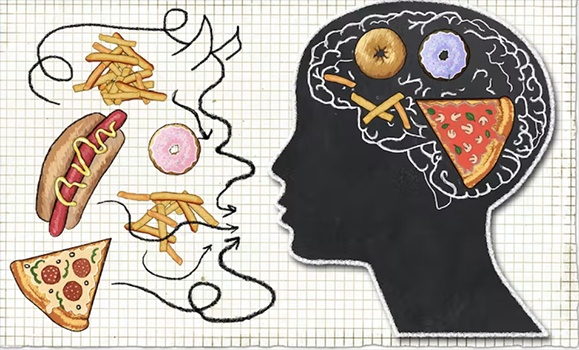聽is a聽Clinical Psychologist and Professor in the Department of Psychology and Neuroscience at聽.
Eating disorders such as anorexia nervosa, bulimia nervosa and binge eating disorder are serious health risks, and can be life-threatening. They are also , especially among teenage girls.
over the age of 15 are diagnosed with an eating disorder each year. Onset usually occurs . In fact, eating disorders are the third most common chronic illness among teens.
Adolescence is also when eating disorders have the greatest negative effects on health. in North America will suffer from an eating disorder in their lifetime, but few people seek treatment. The prevalence of eating disorders and struggles to access help highlight the need to increase awareness and .
Causes and risk factors
The greatest risk factor for eating disorders is sex. Eating disorders occur than in males. However, genetic, biological, psychological and cultural factors all affect the development of an eating disorder.
- Genetics: Specific , and studies of twins suggest eating disorders are very heritable genetic diseases, with rates estimated between . People may be more likely to inherit an eating disorder if their mother was shortly before or after birth.

Biology: such as abnormalities in brain structure or chemistry can cause eating disorders. Developmental disorders such as autism or ADHD affect one-fifth of those with anorexia. Mood disorders such as depression or anxiety are associated with binge eating disorder and bulimia.
Psychology: Eating disorders are more common in people with perfectionism, obsessive compulsive traits, avoidant coping methods and anxiety. People who often have are at risk of eating disorders, as are people who are dependent and sensitive to failure. Individuals with body dysmorphic disorder (who obsess over perceived flaws in their body) are also likely to develop eating disorders.
Society and culture: Eating disorders are that value thinness. (both in shape and size) encourage people to negatively compare their body to others and have poor self-esteem. Those societies also encourage a culture of criticism and bullying around weight. increases the risk of developing an eating disorder.
Unfortunately, eating disorders can be self-propelling. Eating disorders change the way you perceive food and body shape. Starvation also shrinks the brain and causes problems such as rigidity, emotional dysregulation and social difficulties that maintain the illness. The effects of starvation are particularly exaggerated during adolescence because it is a period of growth and vulnerability.
Health effects
Eating disorders are chronic, distressing and impede one鈥檚 ability to function. They of depression, anxiety disorders, obsessive compulsive disorders, personality disorders, substance abuse, morbidity and future obesity.

People with eating disorders are to die than the general population, and likely to attempt suicide.聽In fact, anorexia has an聽.
Eating disorders can also have consequences later in life because of their effects on the skeleton (for example, growth retardation and osteoporosis), reproductive system and brain.
- Anorexia nervosa
hormonal changes, heart problems, electrolyte imbalances, decreased fertility, loss of bone density, anemia and suicidal ideation. Some of these effects can be deadly.
Without enough calories, the body is forced to slow its processes to conserve energy. As such, people with anorexia often complain of stomach cramps, constipation, acid reflux, slow heart rate, swelling in extremities, menstrual irregularities, difficulty functioning, dizziness, sleep disturbances and impaired immunity and healing.
Nutritional deficits can cause dental problems, dry skin, dry and brittle hair and nails, thinning hair and muscle weakness.
People with anorexia are often cold and develop fine hair on their body to help conserve heat. They are also , can suffer higher relapse rates, younger age of onset, more severe psychopathology, lower BMI, higher dissatisfaction with their body and lowered response to treatment.
- Bulimia nervosa
Since bulimia is characterized by periods of both binge eating and periods of purging or starvation, people with bulimia experience many of the same consequences of anorexia. noticeable changes in weight or experience fluid retention.
As a result of induced vomiting, they may have cuts and calluses across the top of finger joints, swelling around salivary glands, esophagus damage and cavities or tooth discoloration.
self-harm, substance abuse, miscarriages, suicide and impulsive behaviours.
- Binge eating disorder
People with weight stigma, noticeable cycles of weight changes, clinical obesity and depression. They are to become overweight or obese compared to the general population, and have double the risk of developing severe depression.
Treatment
Despite how common, chronic and challenging eating disorders are, few people seek treatment. , though. Many behavioural, psychological and physical effects of starvation clear up once weight is gained and brain mass restored.
For anorexia, an approach that tackles medical, nutritional, social and psychological aspects is recommended. For bulimia and binge eating disorder, (which involves identifying, challenging and changing unhelpful thought patterns) has been shown to be effective, as has medication such as the stimulant (lisdexamfetamine).
Eating disorders are serious conditions that can endanger health, but there are effective treatments. There is hope. Increasing awareness of eating disorders helps break the stigma and encourages people to get help.![]()
This article is republished from under a Creative Commons license. Read the .

